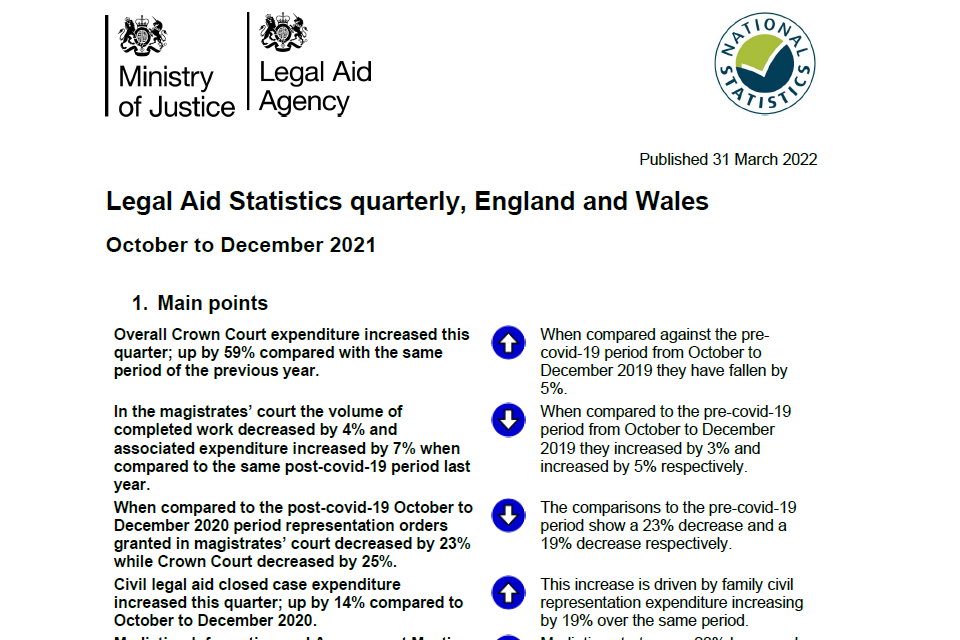Legal aid statistics England and Wales bulletin Oct to Dec 2021
Published 31 March 2022
We are seeking user feedback on the use of HTML for the publication of statistical bulletins. Please send any comments to: statistics@justice.gov.uk.
1. Main Points
Figures for this latest quarter continue to be impacted by the covid-19 pandemic with courts and other parts of the justice system recovering from lockdown and social distancing restrictions.
| Overall Crown Court expenditure increased this quarter; up by 59% compared with the same period of the previous year. | ⬈ | When compared against the pre-covid-19 period from October to December 2019 they have fallen by 5%. | ||
| In the magistrates’ court the volume of completed work decreased by 4% and associated expenditure increased by 7% when compared to the same post-covid-19 period last year. | ⬊ | When compared to the pre-covid-19 period from October to December 2019 they increased by 3% and increased by 5% respectively. | ||
| When compared to the post-covid-19 October to December 2020 period representation orders granted in magistrates’ court decreased by 23% while Crown Court decreased by 25%. | ⬊ | The comparisons to the pre-covid-19 period show a 23% decrease and a 19% decrease respectively. | ||
| Civil legal aid closed case expenditure increased this quarter; up by 14% compared to October to December 2020. | ⬈ | This increase is driven by family civil representation expenditure increasing by 19% over the same period. | ||
| Mediation Information and Assessment Meeting volumes were 17% lower than in the same quarter of 2020. | ⬊ | Mediation starts were 20% lower and outcomes also were 13% lower. | ||
| Applications for civil representation supported by evidence of domestic violence or child abuse decreased by 13%. | ⬊ | The volume of these granted decreased by 15% compared to the same period of 2020. | ||
| 846 applications for Exceptional Case Funding were received in the last quarter. | ⬊ | This is a 5% decrease from the same quarter last year. |
This edition comprises the first release of official statistics for the three-month period from October to December 2021 and the latest statement of all figures for previous periods. For more detailed commentary, and statistics on providers of legal aid, Central Funds and legal aid in the higher courts, please refer to the annual publication. For technical detail, please refer to the User guide to legal aid statistics.
2. Statistician’s Comment
This publication shows that completed workload and the associated expenditure has increased year on year and has also increased more over the recent quarters, due to recovery from covid-19, across both the criminal legal aid and civil legal aid schemes – total civil expenditure is at its highest level since 2014-15. Some areas have seen large increases and this is mainly due to comparisons against low volumes of workload in the early stages of the pandemic and in some instances within the report comparisons are also given against pre-covid-19 volumes, in order to provide a comparison against earlier levels of activity.
Criminal legal aid expenditure increased compared to the same quarter last year in schemes that support the court system, including the magistrates’ and Crown Court. The incoming workload for representation at the courts had returned to levels seen in the period pre-covid-19 but in the most recent period we’ve seen falls in both courts. There are increases in expenditure this quarter compared to the post-covid-19 quarter from last year, however when compared to pre-covid-19 and two years previously, expenditure has still not fully recovered.
Civil legal aid volumes and expenditure show a mixed picture compared to the same quarter last year. Overall civil expenditure is returning to pre-pandemic levels driven by family law expenditure higher than the same quarter in the pre-covid-19 period. Other non-family workload has not recovered to the same extent and this is driven by the slow recovery of housing work following the impact of covid-19. Overall civil legal aid workload still remains below pre-pandemic levels.
It was expected that criminal and civil legal aid volumes would return to, and even temporarily exceed, historic trend levels and more recent falls could be due to this return to normal levels or impact from further lockdowns.
3. Things you need to know
These symbols are used throughout this release to navigate to other documents of interest:
| Web Tool | Help | Tables |
| Click for tool allowing user-defined charts and tables | Click for document giving definitions and explanations | Click for access to tables of figures |
To understand trends in legal aid as a whole, it is best to begin by looking at annual expenditure figures and then look at trends in both workload and expenditure for each category of legal aid. Summarising workload activity across the whole legal aid system meaningfully within a single number is difficult because of the diversity of services included and different stages in delivery. For example, legal aid work can be measured at the point when an order for legal aid is granted, or after all the legal aid work is completed and the provider has been paid. Expenditure on legal aid is measured differently for different purposes. The three most often-used measures, shown in Figure 1, are:
-
Closed-case expenditure is the measure used for expenditure figures throughout these legal aid statistics. It represents the total value of payments made to legal aid providers in relation to pieces of work that are completed in the period. This basis is comparable to volumes of completed work to which it relates, and to the same fine level of detail.
-
RDEL (Resource Departmental Expenditure Limits) nominal is the main budgeting measure used by government to control current spending, both to set budgets for future years and report on how much has been spent. It represents the value of work carried out in the period better than the closed-case measure but cannot be broken down to such a fine level of detail. This measure does incorporate income and expenditure in relation to debt. Nominal here means not adjusted for inflation.
-
RDEL real is the RDEL measure adjusted for inflation to make the value of spending in previous years directly comparable with the specified year.
These measures show a large reduction in legal aid expenditure from around 2010-11, mostly due to changes to the scope of civil legal aid introduced by the Legal Aid, Sentencing and Punishment of Offenders (LASPO) Act from 2013-14, reductions in criminal legal aid workloads and reductions in the fees payable to legal aid providers.
Figure 1: Overall annual legal aid expenditure, by closed-case and RDEL nominal and real terms measures (£m), 2005-06 to 2020-21 (see interactive breakdown here
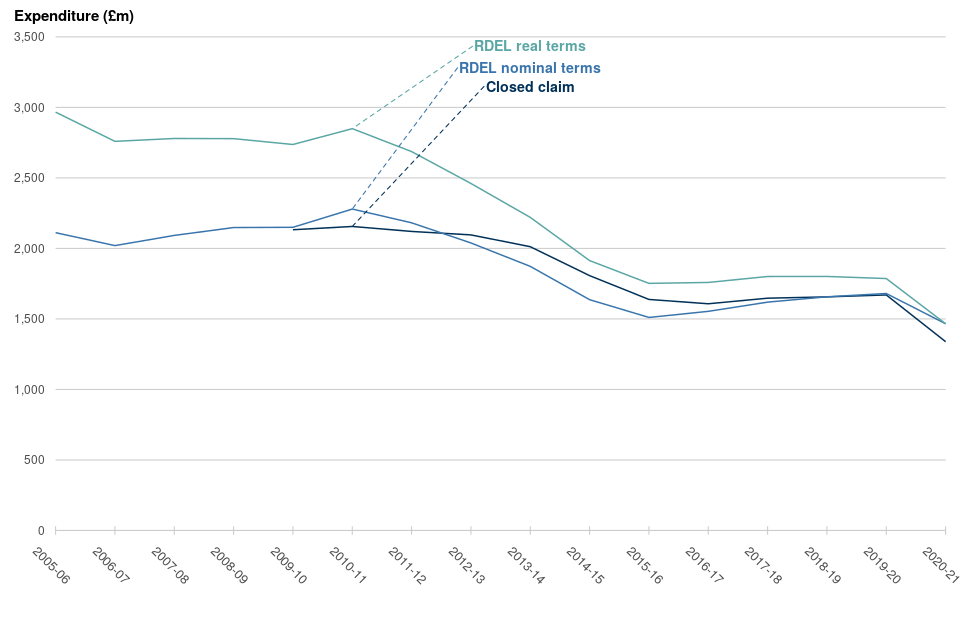
4. Criminal legal aid
| Web Tool | Help | Tables |
Overall Crown Court expenditure increased this quarter; up by 59% in October to December 2021 compared with the same period of the previous year. When compared against the pre-covid-19 period from October to December 2019 they have fallen by 5% so while the Crown Court is showing recovery signs overall workload and expenditure is still below previous levels and this is mainly within the long running and more complex trials ———————————————————————————————————————-
Criminal legal aid can be categorised into Crime Lower and Crime Higher.
Crime Lower (covered in tables 2.1 and 2.2) includes police station advice, magistrates’ court and prison law. Table 2.1 provides the Crime Lower workload whereas table 2.2 gives the Crime Lower expenditure.
Crime Higher (covered in tables 4.1 to 4.4) covers work in the Crown and Higher Courts.
Figure 2: Crime overview, closed case volumes and expenditure for October to December 2021, and comparison with October to December 2020
| Crime Overview | Workload | Expenditure |
|---|---|---|
| Crime | 246,994(2%⬊) | £196.5m (36%⬈) |
| Crime Lower | 207,392(4%⬊) | £61.7m(3%⬈) |
| Crown Court | 39,602(9%⬈) | £134.8m(59%⬈) |
| Crime Lower Category | Workload | Expenditure |
|---|---|---|
| Police Station Advice | 138,908(4%⬊) | £28.5m(1%⬊) |
| Magistrates’ courts | 64,243(4%⬊) | £28.3m(7%⬈) |
| Advice & assistance on appeals | 249(31%⬈) | £466.4k(10%⬈) |
| Prison Law | 3,974(0%⬌) | £4.4m(3%⬈) |
| Civil work associated with crime | 18(38%⬈) | £6.2k(20%⬊) |
| Crown Court Category | Workload | Expenditure |
|---|---|---|
| Solicitor fee scheme | 20,193(5%⬈) | £80.3m(56%⬈) |
| Advocate fee scheme | 19,408(14%⬈) | £54.3m(65%⬈) |
| High Cost crime cases | 1(0%⬌) | £228.2k(53%⬊) |
Although Crown Court work comprises a relatively small portion of criminal legal aid in terms of volume, it accounts for around two-thirds of all criminal legal aid expenditure. Conversely, advice relating to the police station makes up the largest portion of workload, but a much smaller proportion of expenditure.
Figure 3a: Workload in criminal legal aid, April to June 2011 to October to December 2021 (see interactive breakdown of crime lower and crown court)
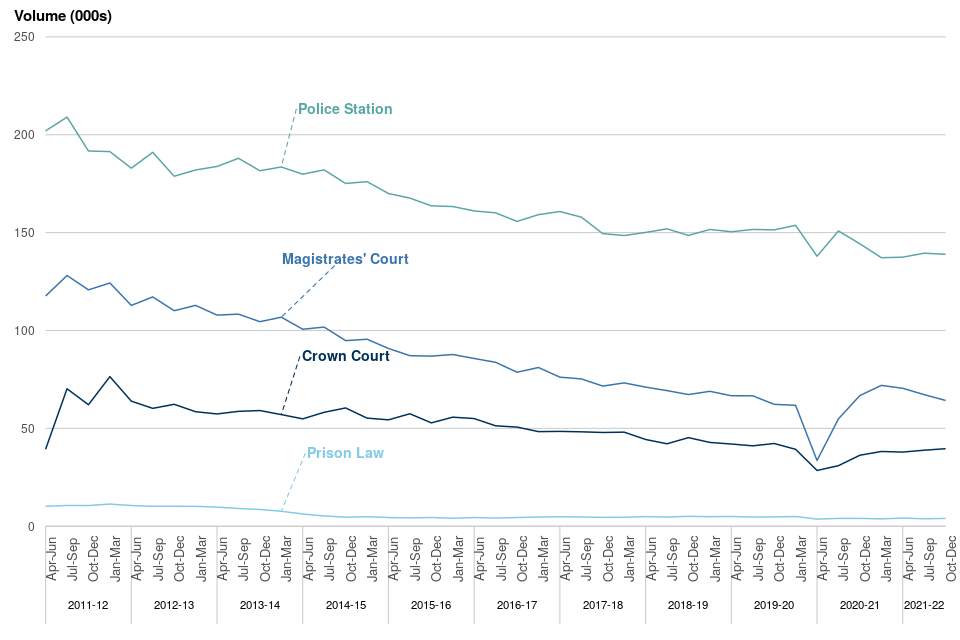
Figure 3b: Expenditure in criminal legal aid, April to June 2011 to October to December 2021 (see interactive breakdown of crime lower and crown court)

Note: Advice and assistance on appeals and civil work associated with crime are excluded from these figures.
4.1 Police station advice
This category made up two thirds of the Crime Lower workload between October and December 2021 but less than half of the expenditure. The workload (covered in table 2.1) in this period has decreased by 4% compared to the previous year, with expenditure (covered in table 2.2) decreasing by 1% (£337k). This continues the general downward trend seen over the last three years. The decrease in police station advice workload since 2013-14 is also seen in arrest statistics for England and Wales[footnote 1] , which has had a similar decline historically.
The majority of the police station advice workload (89% in October and December 2021) consists of suspects receiving legal help with a solicitor in attendance at the police station, with the rest mainly consisting of legal advice over the telephone.
4.2 Applications and grants for representation in the criminal courts
While figures should be interpreted with caution as they may be revised in subsequent quarters as cases move into the Crown court, the number of orders granted for legally-aided representation in the magistrates’ court decreased by 23% this quarter when compared to the same quarter of the previous year. This is attributed to the lockdown which happened in last year’s quarter. In comparison with October to December 2019, the number of orders granted reduced by 26%. This continues the downward trend of the last 3 years, which has been largely driven by Summary Only cases. The proportion of these applications that are granted remains stable at around 95%.
Orders granted for legally-aided representation in the Crown Court (covered in tables 3.2) also decreased to a larger degree, by 25% this quarter compared to last year, this follows the recent trends in overall Crown Court receipts[footnote 2] although when compared to the figure from two years previously there has also been a 15% fall due to the large reduction in the first quarter of the pandemic year. Within the legal aid figure, orders relating to either-way offences decreased by 30%, while those relating to indictable offences decreased by 19%. The proportion of Crown Court applications granted remains at almost 100%.
4.3 Magistrates’ court completed work
Legally-aided representation in the magistrates’ court comprised almost one-third of the workload and just under half of expenditure in Crime Lower between October to December 2021. The volume of completed work (covered in table 2.1) in the magistrates’ court decreased by 4% this quarter when compared to the same period of the previous year. Conversely expenditure increased by 7% (£1.8m). This increase is driven by the accelerated Criminal legal aid reforms since October 2020 which cover payment for work on sending cases to the Crown Court. This new category shown in the tables accompanying this bulletin had 8,959 claims costing around £2m completed this quarter.
4.4 Crown Court completed work
Completed work volumes (covered in table 4.1) within the litigator (solicitor) fee scheme increased by 5% in October to December 2021 compared to the same period of the previous year, driven mainly by a 72% increase in trial claims. This recovery in workload is from extra resource within the HMCTS estate and completion of shorter less complex jury trials from the outstanding backlogs. When compared to the pre-covid-19 quarter in 2019 the current workload decreased by 5% with a 13% decrease in trial claims.
In the advocate fee scheme, completed claims increased by 14% compared to the same period last year. When compared to the pre-covid-19 quarter in 2019 the current workload decreased by 7%.
Figure 4a: Workload in the Crown Court, April to June 2011 to October to December 2021 (see interactive breakdown here)

In the litigator fee scheme (covered in table 4.2), expenditure increased by 56% in October to December 2021 compared to the same period of the previous year (although a 9% decrease against the pre-covid-19 period). In the advocate fee scheme (covered in table 4.3), the value of payments increased by 65% compared to the same period of the previous year. This increase though should be seen in the context of a 5% decrease against the pre-covid-19 period from 2019. Figures for expenditure on work completed in the Crown Court should be interpreted with caution as they may be revised in subsequent quarters as claims are assessed further on appeal and further payments added to the value of some completed claims.
The Very High-Cost Case (VHCC) scheme (covered in table 4.4) covers those Crown Court cases which, if the case were to proceed to trial, would likely last more than 60 days. These cases can span several years and, while they may involve small numbers of defendants, the associated expenditure is high in comparison.
There was one defendant represented in the VHCC contracts that concluded in the October to December 2021 quarter. Expenditure on this work over the duration of the contracts (i.e. on the closed-case basis) was £228.2k. While workload comprises a tiny proportion of legal aid in the Crown Court overall, the VHCC scheme represents less than 1% of the cost, although down from over 15% ten years ago.
Figure 4b: Expenditure in the Crown Court, April to June 2011 to October to December 2021 (see interactive breakdown here)
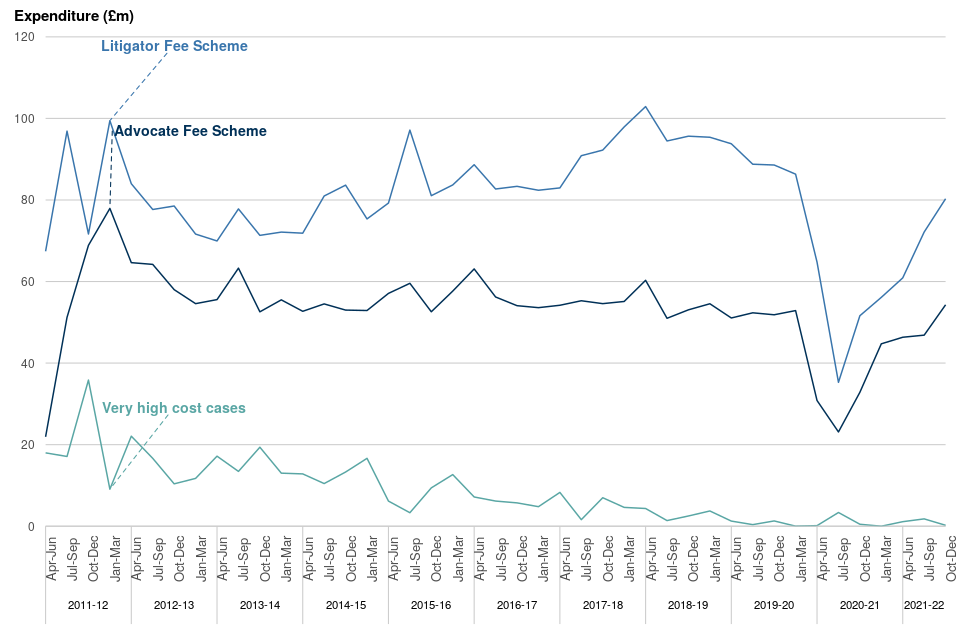
The large falls in completed expenditure are a consequence of the large fall in the number of jury trials completing in the Crown Court, as all expenditure across the case will be in the final main bill. Figure 4c below, looking at the litigator fee scheme in isolation but equally applicable to both schemes, shows the impact of falling trials on expenditure. Trial completed expenditure has been more adversely affected than guilty pleas and cracked trials, where a defendant changes their plea before the trial, with litigator fee expenditure much lower. Previously it was more than £60m and it is still only around two-thirds of this. A lack of available resources has led to fewer jury trials with a subsequent increase in trials awaiting completion.
Figure 4c: Litigator Fee Scheme Crown Court workload and expenditure by claim type, April to June 2017 to October to December 2021 (see interactive breakdown here)

4.5 Prison Law
Workload (covered in table 2.1) this quarter decreased by 5% compared with the same period in the previous year, driven by advocacy assistance at parole board hearings which decreased by 3% compared to last year and has decreased by 9% since last quarter (see figure 5a). Advocacy at parole board hearings currently make up just over two-fifths of prison law workload, but a much larger proportion of costs (77%), so expenditure on prison law overall increased by 3% over this period. Since April to June 2020, the workload and expenditure (covered in table 2.2) for advocacy assistance at prison discipline hearings has remained low. Year-to-year comparisons show that workload decreased by 21% and expenditure decreased by 15% this quarter compared to last year. This continues the downward trend of this prison law category.
Figure 5a: Prison Law completed workload, April to June 2011 to October to December 2021 (see interactive breakdown here)
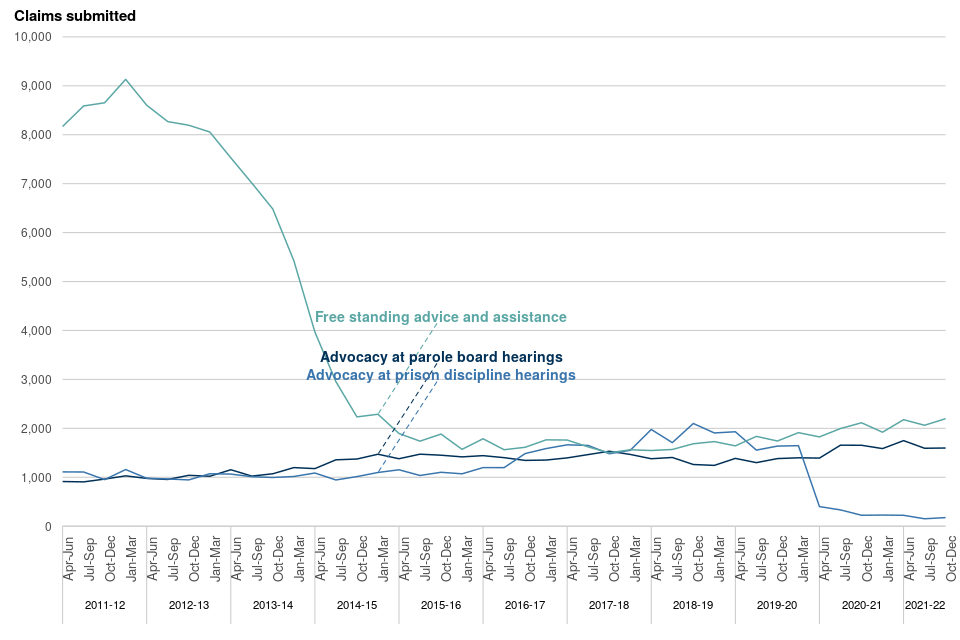
Figure 5b: Prison Law completed expenditure, April to June 2011 to October to December 2021 (see interactive breakdown here)

*New categories not shown: ‘advocacy assistance at sentence reviews’ and ‘advocacy assistance at Parole Board reconsideration hearings’
5. Civil legal aid
| Web Tool | Help | Tables |
Civil legal aid closed case expenditure increased this quarter; up by 14% compared to October to December 2020. This increase is driven by family civil representation expenditure increasing by 19% over the same period. Civil legal aid expenditure exceeds pre-covid-19 levels; up 10% compared to October to December 2019. In the current quarter, civil legal aid workload remained lower than pre-pandemic figures (down 9%). Total Civil Expenditure is the highest it has been since 2014-15.
Civil legal aid can be categorised by area of law into family and non-family. The category of family legal aid covers all work on both private and public family law and includes work associated with the Children Act, domestic abuse, financial provision and family mediation. Non-family legal aid encompasses all work related to immigration, mental health, housing and other non-family law.
Figure 6: Civil overview, closed case volumes and expenditure for October to December 2021, and comparison with October to December 2020
| Civil Overview | Workload | Expenditure |
|---|---|---|
| Civil | 61,134(7%⬈) | £208.4m(14%⬈) |
| Family | 28,551(11%⬈) | £172.4m(18%⬈) |
| Non-Family | 27,910(8%⬈) | £34.6m(3%⬊) |
| Family Category | Workload | Expenditure |
|---|---|---|
| Family Public | 17,799(7%⬈) | £137.6m(16%⬈) |
| Family Private | 10,752(20%⬈) | £34.8m(31%⬈) |
| Mediation and MIAMs* | 4,673(15%⬊) | £1.4m(14%⬊) |
| Non-Family Category | Workload | Expenditure |
|---|---|---|
| Immigration | 10,119(13%⬈) | £9m(4%⬊) |
| Mental Health | 8,319(6%⬊) | £10.4m(5%⬊) |
| Housing | 6,259(28%⬈) | £4.8m(8%⬊) |
| Other Non-Family | 3,213(1%⬈) | £10.4m(1%⬈) |
Although workload for family and non-family law cases are similar, Non-family comprises a relatively small proportion of civil legal aid expenditure. Public family legal aid makes up two thirds of family legal aid work and over 80% of expenditure.
5.1 Legal help and controlled legal representation
In the latest quarter, legal help new matter starts remained unchanged (covered in table 5.1) compared to the same period of 2020. The volume of completed claims (covered in table 5.2) increased by 6% while expenditure (covered in table 5.3) decreased by 3% in April to June 2021 compared to the same period in 2020 (figure 7).
Overall, the recovery of legal help has been slow following the initial impact of covid-19. Although positive, legal help workload and expenditure has not returned to the levels seen pre-pandemic. In the current quarter, new matter starts remained down by 12% from the same period of 2019. The volume of completed claims has fallen by 16% and expenditure has decreased by 23% over the same period.
The implementation of the LASPO Act in April 2013 resulted in large reductions in legal help workload, with the decline in the overall trend being further exacerbated by the effects of covid-19, workload now sits at less than one-quarter of pre-LASPO levels.
Figure 7a: Completed workload in legal help and controlled legal representation, April to June 2011 to October to December 2021 (see interactive breakdown here)

Figure 7b: Completed workload expenditure in legal help and controlled legal representation, April to June 2011 to October to December 2021 (see interactive breakdown here)

5.2 Family legal help
From 1 September 2021, callers to the Civil Legal Advice (CLA) helpline with family issues are no longer referred to specialist telephone advice.
In October to December 2021 family legal help starts (covered in table 5.1) decreased by 22% compared to the same quarter last year. Completed claims (covered in table 5.2) decreased by 3% and expenditure (covered in table 5.3) decreased by 4% Compared to the same period of 2019 (pre-covid-19), family legal help starts are down by 28%, completed claims have decreased by 20% and expenditure has fallen by 15%. There was a steep decline immediately following the implementation of LASPO Act in April 2013, with a more gradual decline to family legal help over the last 6 years.
Family mediation involves an independent and impartial professionally-accredited mediator discussing problems with a divorcing or separating couple. A Mediation Information and Assessment Meeting (MIAMs) is an initial meeting between one or both parties and a mediator to see if family mediation could be used to reach agreement without using the courts. MIAMs (covered in table 7.1) decreased by 17% in the last quarter compared to the previous year and currently stand at around a third of pre-LASPO levels. Family mediation starts (covered along with outcomes in table 7.2) decreased by 20% and total outcomes decreased by 13%, of which 61% were successful agreements, and are now sitting at over half of pre-LASPO levels.
MIAMs, family mediation starts, and outcomes decreased significantly following the covid-19 restrictions in March 2020. Since, volumes and expenditure had rapidly increased to levels temporarily exceeding 2019 figures. However, in the latest quarter, MIAMs have dropped by 4% compared to October to December 2019. Family mediation starts decreased by 11% while outcomes continue to exceed pre-pandemic figures (up 2%).
Figure 8: Family mediation assessments, starts and agreements, April to June 2011 to October to December 2021 (see interactive breakdown MAIMS and starts/agreements)

5.3 Non-family legal help and controlled legal representation
Controlled legal representation relates to representation at tribunal, but unlike civil representation, the decision on whether to grant legal aid is delegated to providers. Legal help and controlled legal representation make up over 95% of both immigration and mental health legal aid cases.
The LASPO Act 2013 made changes to the scope of legal aid for immigration law, but some areas remained in scope. Workload that remains in the immigration category consists largely of asylum-related work. Having fallen by over 45% in April to June 2020, new matter starts (covered in table 5.1) in immigration increased by 19% in October to December 2021 compared to the same quarter of the previous year. Completed claims (covered in table 5.2) in immigration increased by 12% in the latest quarter compared to the previous year and expenditure (covered in table 5.3) increased by 2%. In the current quarter, the number of immigration matters started mirrors pre-pandemic numbers. The volume of claims completed and expenditure is still slowly recovering, however is yet to return to pre-pandemic levels (down 18% and 27% respectively). Within mental health, most funding is spent on providing assistance to sectioned clients appealing the terms of their detention before a mental health tribunal. Mental health new matter starts (covered in table 5.1) decreased by 8% when comparing the latest quarter to the previous year. Completed claims (covered in table 5.2) also decreased by 6% and expenditure (covered in table 5.3) decreased by 8% over the same period. Compared to respective pre-pandemic period of 2019, mental health new matter starts, completed claims and expenditure have fallen (by 11%, 13% and 18% respectively)
Over 80% of legal aid housing work volume is made up of legal help. The volume of legally aided housing work halved between July to September 2012 and July to September 2013. The trend then fluctuated for around 18 months but since 2014 it has been falling. Housing legal aid has been particularly affected by covid-19 with starts and completed claims nearly halving again between January to March 2020 and April to June 2020. In October to December 2021 there was a 24% increase in housing work starts (covered in table 5.1) compared to the same quarter the previous year. There was also a large increase in completed claims (36%) and decrease in expenditure (6%). Housing legal help has not returned to levels seen pre-pandemic. When compared to the same period of 2019, housing legal aid starts is down by 16%, completed claims by 13% and expenditure remained 15% below comparative pre-pandemic figures.
5.4 Civil representation
The number of civil representation certificates (covered in table 6.2) granted in the last quarter decreased by 6% compared to the same period of the previous year. The number of certificates completed (covered in table 6.3) however increased by 14%, and the associated expenditure (covered in table 6.5) also increased by 17% over the same period (Figures 11a and 11b).
Compared to the same period of 2019 (pre-covid-19) certificates granted in the last quarter remain slightly lower (9%). The number of certificates completed has decreased by 2% while the associated expenditure exceeds 2019 figures by 16%.
Figure 9a: Completed workload in civil representation, April to June 2011 to October to December 2021 (see interactive breakdown here)
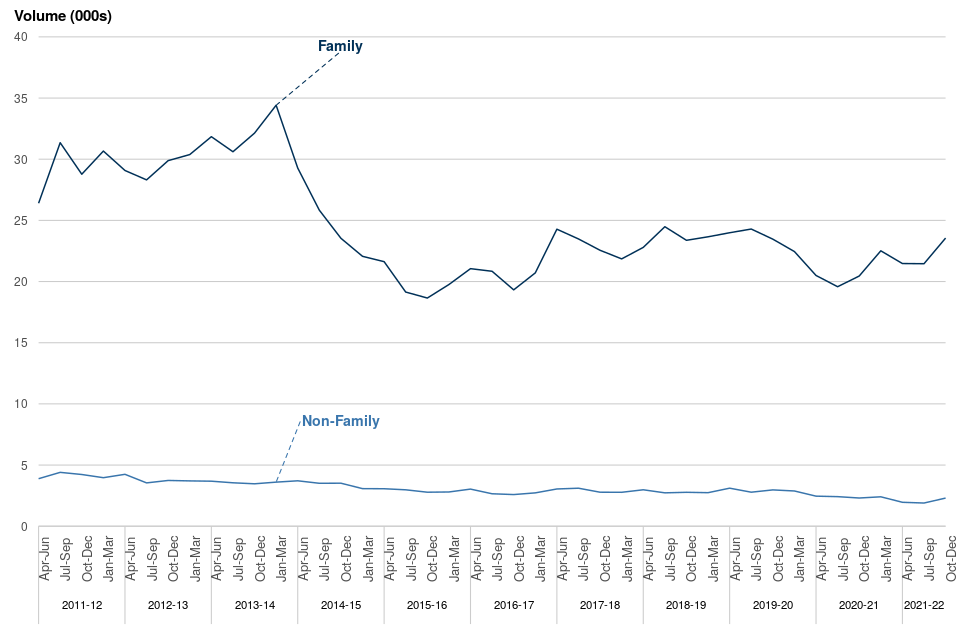
Figure 9b: Completed workload expenditure in civil representation, April to June 2011 to October to December 2021 (see interactive breakdown costs met by LAA and costs met by opponent)
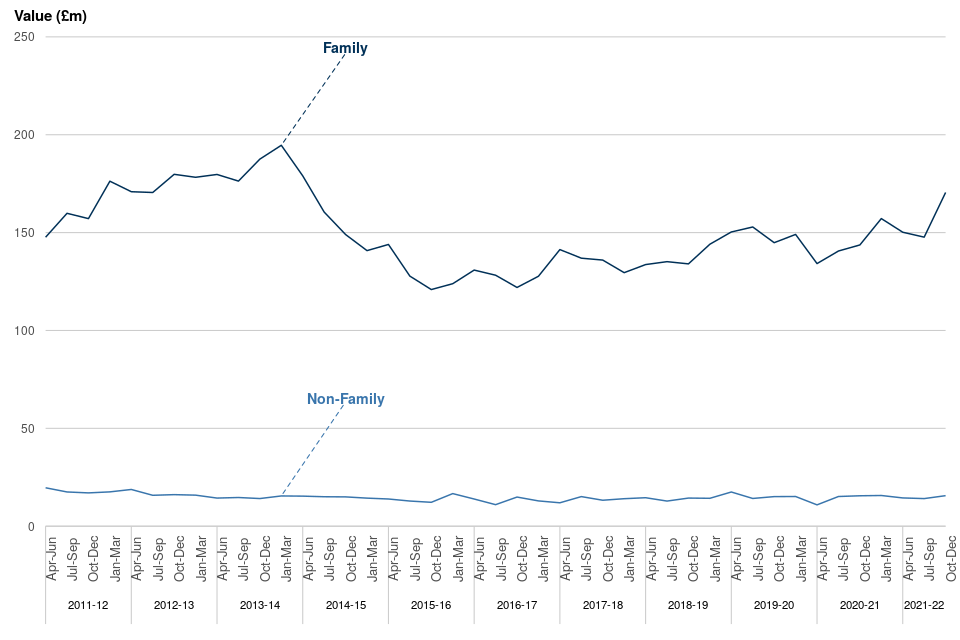
5.5 Non-Family Civil Representation
Non-family certificates completed make up 11% of the total civil representation workload and 8% of the expenditure. There are only a small number of immigration and mental health cases in civil representation as most work in these areas consists of controlled legal representation. Housing work represents a large proportion of non-family certificates completed. There has been a gradual decline in housing certificates completed and expenditure since 2014. In the latest period, completed certificates (covered in table 6.3) remained unchanged compared to the same period of the previous year and sits 46% lower than the same pre-pandemic period of 2019.
5.6 Family civil representation
While civil representation for public family law remains available, the LASPO Act removed legal aid for most private family law including issues such as contact or divorce. However, legal aid remains available for such cases where there is a risk of domestic violence or child abuse. Certificates granted for family work decreased by 8% in October to December 2021 compared to the previous year. Whereas, certificates completed increased by 15% and associated expenditure has increased by 19% compared to the same quarter the previous year. Compared to the respective pre-covid-19 quarter of 2019, family certificates completed remain unchanged and closed case expenditure for family civil representation exceeds pre-pandemic levels (up 18%). Although, certificates granted in October to December 2021 have fallen by 6%. The volume and expenditure for closed case domestic violence civil representation increased rapidly following covid-19 and continues to exceed pre-covid-19 levels substantially (50% and 53% higher respectively – compared to October to December 2019). At 5,397 certificates issued in October to December, this is the highest level seen in our series.
In October to December 2021, applications for civil representation supported by evidence of domestic violence or child abuse decreased by 13% compared to the same period of the previous year. The number of these granted decreased by 15% over the same period. The proportion of applications granted remained steady at around 70% from the inception of this type of application until the end of 2015, before increasing to around 80%. The provisional figure for the latest quarter is 83%.
Figure 10: Applications received and total certificates granted via the domestic violence and child abuse gateway, April to June 2013 to October to December 2021 (see interactive breakdown applications received and certificates granted)
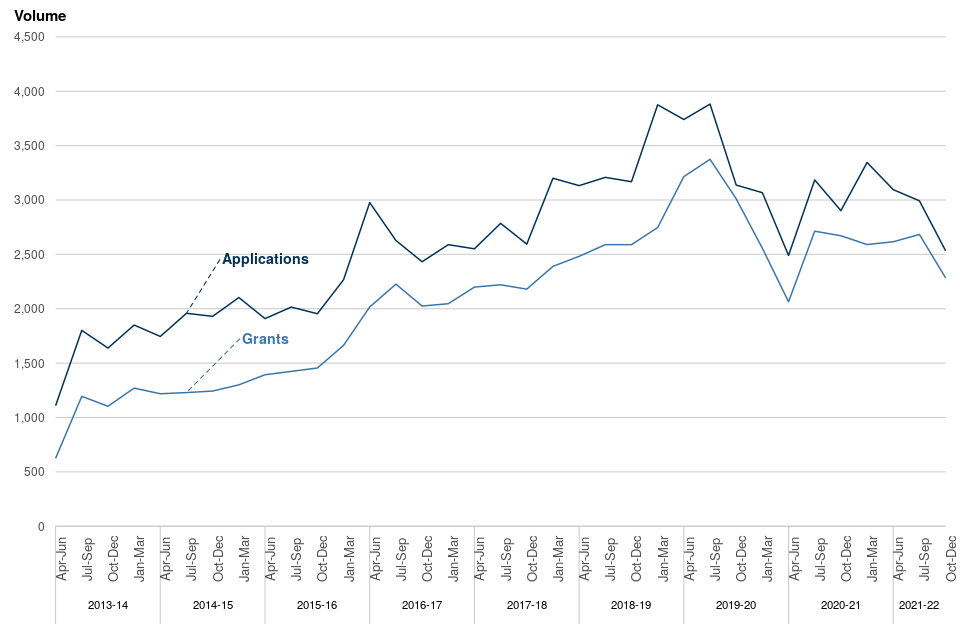
5.7 Judicial reviews
Of all civil representation applications granted, around 3,000 a year relate to judicial review; 738 in the last quarter. The number granted in October to December 2021 increased by 1% compared with the same quarter in 2020. Over a half of judicial reviews were for public law. Judicial review data is available in the detailed csv accompanying this bulletin.
5.8 Exceptional Case Funding (ECF)
The Exceptional Case Funding (ECF) scheme was introduced as part of LASPO. An ECF application for civil legal services is made where a case falls outside the scope of civil legal aid but the client or conducting solicitor believes failure to provide funding would be a breach of the Human Rights Act 1998 There were 846 applications (covered along with its current status, details and determination or outcome is provided in table 8.1) for ECF received from October to December 2021. This is a 5% decrease from the same quarter last year and a 12% decrease from the same period of 2019. 781 (92%) of these were new applications. Of the 846 ECF applications received between October and December 2021, 95% (804) had been determined by the LAA as of 01 March 2022. 76% (609) of these were granted, 14% (109) were refused and 8% (63) rejected (see figure 11).
Figure 11: Volume of ECF applications received, April to June 2014 to October to December 2021 (see interactive breakdown here)

Among the ECF applications received between October to December 2021, immigration (69%), inquest (10%), and family (12%) remained the most requested categories of law. The increase in ECF applications over the last four years is driven by an increase in immigration applications. A breakdown of ECF applications and grants by category of law is provided in table 8.2.
Figure 12: Volume of ECF determinations by outcome, April to June 2015 to October to December 2021 (see interactive breakdown here)
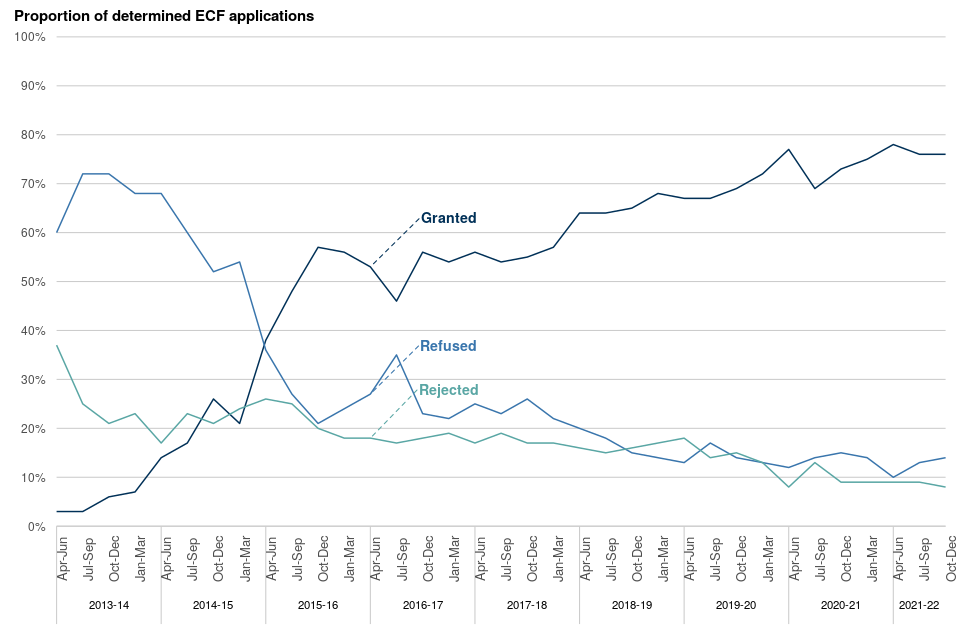
6. Further information
This publication presents quarterly data trends. For figures published annually, including those on providers of legal aid, appealing legal aid decisions, Central Funds, butterfly charts and legal aid in the higher courts, please refer to our annual publication.
Our statisticians regularly review the content of publications. Development of new and improved statistical outputs is usually dependent on reallocating existing resources. As part of our continual review and prioritisation, we welcome user feedback on existing outputs including content, breadth, frequency and methodology. Please send any comments you have on this publication including suggestions for further developments or reductions in content.
6.1 National Statistics status
National Statistics status means that official statistics meet the highest standards of trustworthiness, quality and public value. All official statistics should comply with all aspects of the Code of Practice for Official Statistics.
They are awarded National Statistics status following an assessment by the Authority’s regulatory arm. The Authority considers whether the statistics meet the highest standards of Code compliance, including the value they add to public decisions and debate.
It is the Ministry of Justice’s responsibility to maintain compliance with the standards expected for National Statistics. If we become concerned about whether these statistics are still meeting the appropriate standards, we will discuss any concerns with the Authority promptly. National Statistics status can be removed at any point when the highest standards are not maintained, and reinstated when standards are restored.
7. Contact
Press enquiries should be directed to the Ministry of Justice press office: Tel: 020 3334 3536 Email: newsdesk@justice.gsi.gov.uk
Other enquiries about these statistics should be directed to the Justice Statistics Analytical Services division of the Ministry of Justice:
Carly Gray,
Ministry of Justice
Tel: 07784 275495
Email: statistics@justice.gov.uk
8. Tables and Data
- A set of ‘Tables’, which give further detail and full time-series for each scheme.
- An ods spreadsheet download for all ‘Tables’, which provide full time-series for each scheme.
- Main data and Civil detailed data: Detailed files to enable independent analysis, provided in .csv (Comma delimited) format.
9. Help
-
User Guide to legal aid statistics: This provides comprehensive information about data sources as well as key legislative changes.
-
Index of data in Legal aid statistics: A guide to the data published in the .ods files, lists of available data from Legal Aid systems and guidance on how to work with the data.
-
Quality Statement: This provides detail on how legal aid statistics meet user needs
10. Web tool
- Data visualisation tool A web-based tool allowing the user to view and customize charts and tables based on the published statistics.
Next update: 30 June 2022
URL: https://www.gov.uk/government/collections/legal-aid-statistics
© Crown copyright Produced by the Ministry of Justice
Alternative formats are available on request from statistics.enquiries@justice.gov.uk
11. Print version in pdf
